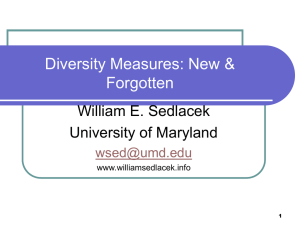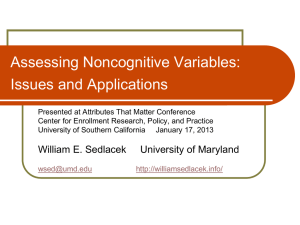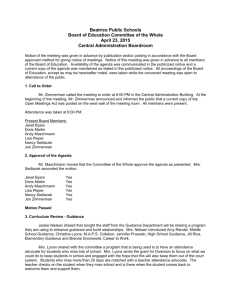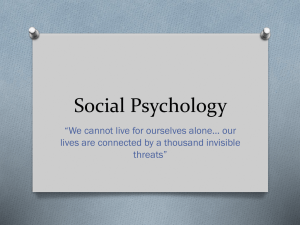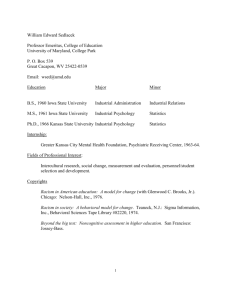The Measurement of Prejudice
advertisement
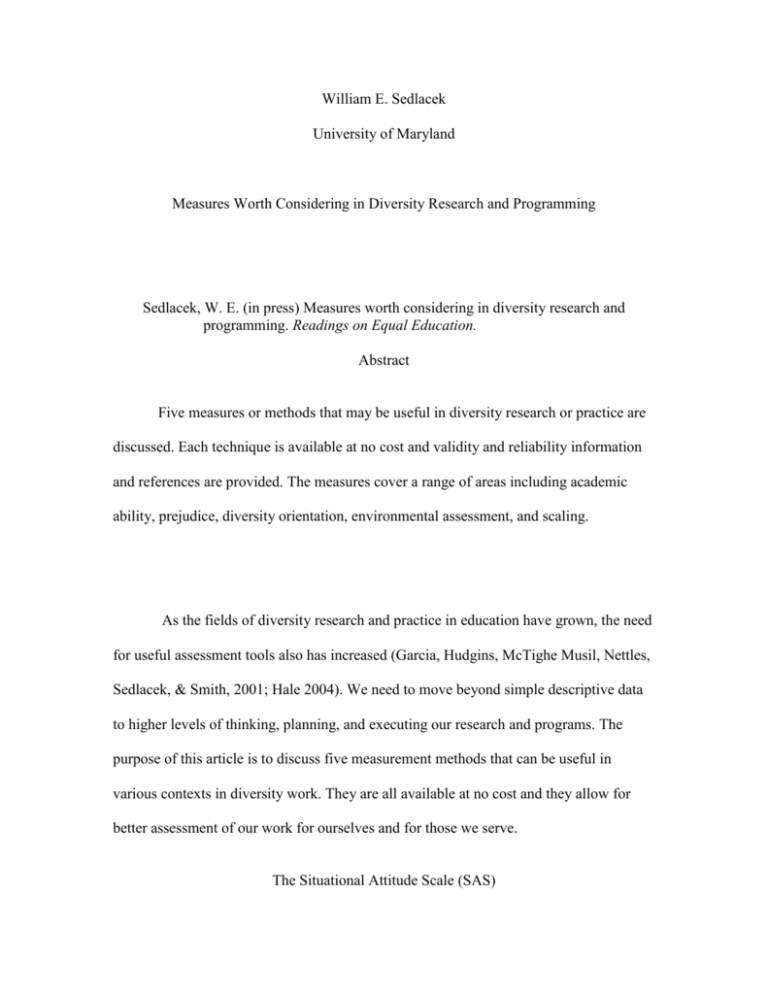
William E. Sedlacek University of Maryland Measures Worth Considering in Diversity Research and Programming Sedlacek, W. E. (in press) Measures worth considering in diversity research and programming. Readings on Equal Education. Abstract Five measures or methods that may be useful in diversity research or practice are discussed. Each technique is available at no cost and validity and reliability information and references are provided. The measures cover a range of areas including academic ability, prejudice, diversity orientation, environmental assessment, and scaling. As the fields of diversity research and practice in education have grown, the need for useful assessment tools also has increased (Garcia, Hudgins, McTighe Musil, Nettles, Sedlacek, & Smith, 2001; Hale 2004). We need to move beyond simple descriptive data to higher levels of thinking, planning, and executing our research and programs. The purpose of this article is to discuss five measurement methods that can be useful in various contexts in diversity work. They are all available at no cost and they allow for better assessment of our work for ourselves and for those we serve. The Situational Attitude Scale (SAS) This is an approach to measuring prejudice. It has been applied to many types of prejudice with some success in providing score reliability and validity in isolating situation-based sources of prejudice. I have found the method useful in helping to identify what groups we should include in our conceptions of diversity (Sedlacek, 1996). I have used the term “nontraditional” to describe such groups. The Measurement of Prejudice The initial step in assessing whether a given group is to be considered "nontraditional" is whether they experience prejudice. Prejudice here is defined as some negative attributions or consequences of being a member of a certain group. Measuring the degree of prejudice against a group has been difficult because of the tendency many people have to mask or avoid expressing such feelings because of social desirability. In response to this measurement problem, Sedlacek and Brooks (1970) developed the Situational Attitude Scale (SAS). The SAS employs experimental and control forms and provides a situational context to make the psychological withdrawal from the stimulus more difficult. The SAS methodology has been shown to have evidence of reliability and validity of scores in assessing attitudes toward racial and ethnic groups such as American Indians (Ancis, Bennett-Choney, & Sedlacek, 1996), Arabs (Sergent, Woods and Sedlacek, 1992), Blacks (Balenger, Hoffman, and Sedlacek, 1992), Hispanics (White and Sedlacek, 1987), and Jews (Gerson and Sedlacek, 1992). The SAS has also been employed in measuring attitudes toward persons with disabilities (McQuilkin, Freitag and Harris, 1990); older persons (Schwalb & Sedlacek 1990); Mormons (Gilman, 1983); women (Minatoya and Sedlacek, 1983); commuting students (Wilkshire, 1989); gays, lesbians, and bisexuals (Washington, 1993); athletes (Engstrom and Sedlacek, 1991); and African-American counseling clients (Stovall, 1989). This list is not intended to be exhaustive, but only illustrative of some of the groups to which the SAS has been applied. Also, there is no assumption that there is prejudice against a given group or that it is equally strong or socially relevant for all groups. While it is possible to attempt to measure prejudice of any group toward another, the methodology has been employed mostly in assessing prejudice of groups with more power toward groups with less power. The SAS methodology can be used to determine the presence or absence of prejudice and the degree to which it is present. The test-retest and coefficient alpha reliability estimates for scores are in the .70 to .89 range. Creating SAS Situations The first step is to develop a set of situations that may generate prejudice toward a given group from another group. These can be obtained from publications (popular or professional), focus groups, brainstorming sessions or pilot studies. For example, research literature and popular press reports indicated that if we wish to assess attitudes of Whites toward African-Americans, living in close proximity may evoke prejudice among some Whites. So several situations dealing with roommates, and people living in one's neighborhood were pilot tested prior to inclusion in a final instrument. A useful technique is a brainstorming session involving representatives of the group to which the scale will be administered where stereotypes and situations which might engender prejudice are discussed. By asking for examples they might have seen in others, one can reduce the reluctance to discuss one's own feelings. It is important to note that situations should be relevant to the group being assessed and expressed in their terminology. For example, in a discussion with able-bodied persons, the word "handicapped" was commonly employed when discussing persons with physical disabilities, so that stimulus term was employed, since the point is to try to elicit a prejudiced response from that group, not to be politically correct, or to use terms that might be employed by another group. Table 1 shows one situation developed in a form of the SAS designed to assess attitudes toward "Arabs". The term Arab does not have a precise meaning (Patai, 1973) but is used routinely to express negative attitudes by "non-Arabs". Constructing Multiple SAS Forms After the situations have been developed, two or more forms of the SAS version are created. One form (A) is neutral and makes no mention of a particular group in the situation. A second form (B) includes the stimulus term of interest; in Exhibit 1, "Arab". Thus the only difference between the forms is that term, and hence any mean difference noted in responses to the two forms randomly assigned to a group must be due to the stimulus term, using the logic of experimental and control conditions. The SAS has been designed to elicit both overt and less conscious feelings and to control for socially desirable responses. The SAS has typically comprised 10 personal and social situations with some relevance to the particular form of prejudice being studied, followed by 10 bipolar semantic differential scales (Osgood, Suci, & Tannenbaum, 1957) for each situation. Participants are not aware that other forms exist or that comparisons are being made. Consequently, the validity of the SAS is determined by the mean response differences between the two or more forms. Semantic differential items which are evaluative (as opposed to those showing power or movement) usually work best in eliciting reactions to the situations. Situation scores can be calculated, making sure to reflect the polarity of items so they are scored in the same direction. The homogeneity of the situations can be further analyzed using factor analysis or cluster analysis. While it is possible to create more than two forms, it is important that the situations be relevant to expressing prejudice toward the two or more groups in the experimental forms. Situations that might elicit prejudice toward one group might not work with another group. For example, personal situations usually elicit the strongest negative reactions toward Blacks from non-Blacks (Carter, White and Sedlacek, 1987), but more public situations tend to generate the most negative reactions to gays, lesbians and bisexuals (Washington, 1993). In a study of attitudes toward persons with physical disabilities, three stimulus terms (neutral, blind, and wheelchair) showed differences with the same series of situations (Stovall and Sedlacek, 1983). Summary of SAS Methodology After relevant situations are created and semantic differential evaluative scales developed, experimental and control forms of the instrument are constructed. Forms are randomly assigned to participants, situation scores are calculated and differences among forms determined. A possible way to analyze form differences is with Multivariate Analyses of Variance (MANOVA) with form as an independent variable and situation scores as dependent variables. Exhibit 1 shows an example of form differences by situation on the SAS-Arab. Interactions of form by other variables (e.g., gender) are also possible. Thus, the SAS methodology allows for flexibility of form development in that forms could be uniquely developed for particular circumstances. For example, if a given campus was experiencing difficulties in certain situations between members of particular groups, the SAS methodology would allow for a quantification of those circumstances. This could not only help to determine who might be "nontraditional" in certain circumstances but what situations might be focused upon to reduce prejudice and help to solve some of the problems involved. If an SAS is administered to a diverse group, a discussion of why members of different groups would have different reactions to situations might prove useful. With individual clients it would be possible to compare SAS scores to norms. Noncognitive Variables One interpretation of how to improve our academic ability assessment measures is to hone and fine-tune them so that resulting scores are equally valid for everyone. However, if different groups have different experiences and different ways of presenting their attributes and abilities, it is unlikely that we could develop a single measure, test item, etc. that scores could be equally valid for all. If we concentrate on results rather than intentions, we could conclude that it is important to do an equally good job of assessment for each group, not that we need to use the same instrument for everyone. Standardized tests such as the ACT, SAT, or GRE were designed to predict firstyear grades at a time when most students were White, male and upper-middle class. The tests performed this function fairly well for these students throughout the years, and still do. As colleges and universities have admitted more females, and students with a wider range of cultural, racial and socio-economic characteristics, standardized tests have not correlated as well with grades for these groups (Sedlacek, 1989, 2004, 2005). Generally, these tests were not designed to correlate with grades beyond the firstyear, with retention in any year, or with graduation and success beyond college. They tend not to correlate well with these criteria for any group, including White, upper-middle class males (Sedlacek, 2004). In the case of students from “minority” racial and cultural groups with less power, the standardized tests are less related to these criteria (Sedlacek, 2004). Why don't standardized tests relate to measures of student success beyond the first-year? Aside from not being designed to do so, Sternberg (1996) points out that such tests measure only one aspect of intelligence, analytic ability. He defines analytic ability as "one's capacity to interpret information in a well-defined and unchanging context." Sternberg feels standardized tests generally do not measure synthetic ability or systemic ability; the two other components of intelligence he identifies. Persons with synthetic ability are able to interpret information in changing contexts. They can easily shift from one perspective to another. They are creative, and are likely to be the best researchers or contributors to their fields. Persons with systemic intelligence know how to interpret and use the system or environment to their advantage. They are "street-wise." If we examine a typical curriculum, many would agree that synthetic and systemic intelligence come into play more in the later years of most programs since upper-level courses tend to require students to write more, discuss more, and hopefully think more. Analytic skills, as defined by Sternberg, appear less useful by themselves beyond the first-year. The Noncognitive Questionnaire The Noncognitive Questionnaire (NCQ) is designed to assess attributes that are not typically measured by other instruments and that may be common ways for persons with nontraditional experiences to show their abilities (Sedlacek, 2004, 2005). The term NCQ will be used here to describe a variety of ways that the noncognitive variables shown in Exhibit 2 can be measured; including several paper and pencil or online questionnaires, interview formats, application reviews and profile analyses (see Sedlacek, 2004 for examples). If the NCQ systematically correlates more with the success of members of a given group (e.g., Blacks) than it does for traditional White males, then the group meets the second criterion for inclusion as a nontraditional group. The noncognitive variable system noted in Exhibit 2 appears to measure synthetic and systemic ability. Thus, the task for the counseling professional is to tap the client's full range of abilities by doing all the assessments necessary. Members of nontraditional groups tend to need synthetic and systemic abilities to survive more than people with more traditional experience. For instance, realistic self-appraisal appears to be a synthetic ability while handling racism shows a systemic ability. Equality should be equality of outcome not process. If, to do our best job, we need to assess different ways of showing abilities for different people, let's do it. Scores from the NCQ has been shown to have validity in assessing the academic potential of a variety of nontraditional groups including Blacks (Sedlacek, 2004, Sedlacek & Sheu, 2004, in press; Tracey and Sedlacek, 1989), Hispanics (Fuertes and Sedlacek, 1993; Sedlacek & Sheu, 2004, in press), Asians (Fuertes, Sedlacek, and Liu, 1993; Sedlacek & Sheu, 2004, in press), international students (Boyer and Sedlacek, 1988), women (Ancis & Sedlacek , 1997) and athletes (Sedlacek and Adams-Gaston, 1992). These studies have shown that the NCQ scales predict the grades, retention and graduation from college and are useful in scholarship selection and retention programs (Sedlacek, 2004). Reliability estimates (test-retest and coefficient alpha) range from .70 to .94 for scores from the eight scales with a median of .85. Summary of NCQ Methodology One can do assessments of noncognitive variables using several versions of a paper and pencil or online instrument, interviews, profile analyses, or application reviews for admissions, scholarship programs, financial aid, or support programs (see Sedlacek, 2004). Different methods of measuring the noncogntive variables shown in Exhibit 2 have been employed by the Gates Millennium Scholars program (Sedlacek & Sheu, 2004, in press), the Washington State Achievers program (Sedlacek & Sheu, 2005) and Oregon State University (2008) among others. By doing assessments on noncognitive variables, one can increase the likelihood of achieving a more diverse class without directly focusing on a given group. Doing more comprehensive assessments can move us toward a determination of which persons might be considered nontraditional in our work with individuals or groups. Additionally, post-enrollment counseling, advising, and mentoring programs based on noncognitive variables can be developed (Sedlacek, Benjamin, Schlosser, & Sheu, 2007). Orientation to Diversity The concept of Universal-Diverse Orientation (UDO) may provide an important new direction for assessment in multicultural counseling and diversity programming (Fuertes, Miville, Mohr, Sedlacek, & Gretchen, 2000; Fuertes, Sedlacek, Roger & Mohr, 2000). UDO is the movement toward or away from diversity rather than simply the presence or absence of prejudice and consists of three sub-scales that measure cognitive, behavioral, and affective aspects of diversity perceptions, respectively: Relativistic Appreciation, Diversity of Contact, and Comfort with Differences. Together, these three subscales yield a full-scale UDO score that indicates an overall orientation toward diversity. The UDO assessment instrument has been shown to be correlated with a number of aspects of student functioning including past academic achievement (Singley & Sedlacek, 2003) and satisfaction (Sheu, Sedlacek & Singley, 2003). Differences have been found between males and females as well as among racial/ethnic groups (Asian/Asian-American, African American, Latino/as on the UDO (Singley & Sedlacek, in press). White student total scores were significantly lower than those of people of color, Asian Americans had higher scores than White students on the Diversity of Contact subscale, and males scored significantly lower than females on overall UDO (Fuertes, Sedlacek, Roger, & Mohr, 2000). Perceptual Mapping A physical settings approach to environmental assessment called Perceptual Mapping has been developed and researched. Perceptual Mapping is unique in that it uses maps in both the data collection and the data presentation stages of research. Perceptual Maps can be developed for any space, inside or outside a building. The Perceptual Map depicted in Figure 1 represents the results of an evaluative study conducted in a student union at a major university (Sergent & Sedlacek, 1989). In this study, a map of the student union building was presented to a random sample of undergraduate students. The students were instructed to indicate their responses to each of 10 items by marking their preferences on the map. For example, students were requested to place an “A” on the map in the one place where they felt most comfortable, a "B" on the map in the place that they most often frequented, and a ”C” on the map in the place that least met their needs. The measure, which included 10 items to which participants responded, required approximately 5 minutes to administer. Response frequencies were compiled for each item and were recorded on the map in the format indicated in Figure I. The Perceptual Map can use posies to depict data quantities. Posies are a method used by cartographers to represent geographical characteristics. This posey method was first used in England in the early 1970s to map geochemical properties. Each arm of a posey represents a different item dimension to which participants responded. The relative length of the arm represents the number of participants who chose this area in response to a particular item. In this particular application, posey arms that point down represent negatively valenced items (e.g., The place in which I feel the least comfortable), and arms that point up represent positively valence place in which 1 feel the most comfortable). Thus, responses to each of five items may be represented by each posey figure. The items used in this application are represented in the key in Figure I. An additional visual method for representing perceptions involves a series of transparent plastic sheets that are commonly used with an over- head projector. In this method, responses to each item are represented on a separate transparent page on which the map of the physical space of interest (e.g., a student union) is superimposed. The number of responses to each item is categorized into frequency ranges, and each range is assigned a different color. Maps are coded according to these frequency range colors. Each item to which participants responded is represented on one unique map, and each color represents the number of responses to that item. When these color coded sheets are stacked one on top of the other, an overall representation of the data set appears. This mapping method provides an ideal format for presenting data to large groups of individuals because the results are easily visible and can be readily interpreted by those with varying experience in studying data analysis results. Methodological Advantages of Perceptual Mapping One benefit of Perceptual Mapping is its focus on the perceptions of individuals in the environment. It provides participants with an objective representation of the physical environment and assesses perceptions or feelings about the designated space. The Perceptual Map may include both behavioral (e.g., Designate on the map the place that you most commonly use) and perceptual or attitudinal items (e.g., Designate on the map your favorite place). Items may be designed to measure specific characteristics of the environment. Additional items might instruct participants to designate those areas with which they are familiar, areas in which they most often meet with friends, areas that they would most like to see improved, areas that they tend to avoid, and so on flexibility in the choice of items is a unique benefit of perceptual mapping. Perceptual mapping provides an additional benefit for the evaluation of overall environments related to diversity. Mitchell, Sedlacek & Sergent (1997) found a number of differences in perceptions of campus space by race. White students had visited the campus more often than African American students. More African American than White students named a recreational area as a familiar location while more White students than African American students named the student union as familiar. Such information can be used in orientation programs and in further exploring why particular feelings or behaviors are associated with certain spaces. Longerbeam & Sedlacek (2006) used the UDO in assessing pre and post effects of a living learning diversity experience. One campus that I worked with used Perceptual Mapping in identifying the best design for new computer labs being built. It is a methodology that is easily used by individuals with minimal experience in research and statistical design. Individuals unfamiliar with statistical analyses and tables can interpret the Perceptual Mapping results because the map format is familiar and. makes clear the programmatic and design implications of the results. If statistical analysis of group differences in perceptions of the physical environment is desired, chi square or other appropriate statistical techniques can be applied to test differences in the frequency of responses of two or more groups. I have achieved 90% test-retest reliability of perception locations on a map. Thurstone Equal-Appearing Intervals Thurstone Equal-Appearing Intervals (Edwards, 1957; Thurstone, 1959; Trochim, 2002) is a scaling method that could be used in a number of ways in diversity assessment. The technique seems to have been overlooked in recent social science literature (Roberts, 1998), although the original work was published in 1929 (Thurstone and Chave). The July/August, 2002 issue of the Monitor on Psychology, published by the American Psychological Association, reported on the top 100 psychologists of the 20th century. L.L. Thurstone was on the list, but his name was spelled Thurston. Fame has a poor memory and a sense of irony. The Equal-Appearing Intervals Method The first step in the Equal-Appearing Intervals procedure is to have a group of judges rate the extent to which a large pool of items reflects a certain attribute. Thurstone employed 300 judges in the original work, but many fewer may be necessary. I have had as few as 10 judges be able to make reliable ratings. The number of judges, and initial items required, depends on the simplicity of the content being scaled. The item pool should be much larger than the number of items you wish to use in the final scale. Instructions to judges are to rate the items based on how most people in your target group would rate the items, rather than the judges own feelings about the items. Thurstone used an 11 point scale, to have judges rate the extent to which the items were positive or negative in assessing a certain attitude, although I would recommend any number of scale points from 5 to 11. Judges rated the extent to which the items reflected positive or negative feelings toward “Negroes” in the original work (Thurstone & Chave 1929). Another key point about choosing judges is to make sure that they understand the target group, and that they are not too ego-involved in the attribute. For example, if you are studying faculty, it would be important to have judges who understand faculty functions. At the same time, judges must be objective enough to make fine distinctions among the items. For example, Thurstone and Chave found that “Negro” judges could not distinguish among levels of positivity or negativity in attitudes toward “Negroes”, in a scale intended to assess attitudes of Whites toward “Negroes”. Items are then selected that judges have agreed upon in their value along the 11 point scale (e.g. low variability), and whose medians or means, are spread along the 11 point continuum. Therefore, if items are selected at half point intervals (e.g. 1, 1.5,2, 2.5 etc.) you would have a total of 22 items in your final scale. The items can be at approximately equally spaced intervals, rather than at exact points. The object is to get a good range of choices in your final scale. The instructions to respondents in your final assessment would be to select the items with which they agree. The respondent’s attitudes, behaviors, or score on the scale, is the mean or median of the items that they have chosen. For example, let’s say we are developing a measure of interracial behavior and we have 22 items in our final scale. If a given person feels four of those statements seem to be descriptive of what they actually do, we would calculate the mean or median of those four items, which would be the score for that person. In Thurstone’s original work, semi-interquartile ranges were used to determine variability, and medians were used for central tendency estimations. However, I have employed standard deviations and means effectively in different projects. Advantages and Disadvantages of Equal-Appearing Intervals The primary advantage of the Thurstone Equal-Appearing Intervals method is that the item analysis is done before the items are administered to respondents, so the final number of items is smaller. Hence, it can save time and money and be more focused on individual counseling or advising programs as well as employee evaluation systems compared to the widely used Likert or Summated Ratings procedure (Edwards, 1957). Equal-Appearing Intervals may be a more ethical approach than Summated Ratings, in that participants are not required to respond to items that may not be utilized, due to elimination in post-administration analyses. Also, since items are preweighted there is less need for interpretation in decision making about results. Another advantage of Equal-Appearing Intervals scaling is that it can be used easily in studies of behavior rather than attitudes. By scaling behaviors, the problems with a “halo effect”, and skewed distributions, may be reduced, compared to measuring attitudes. Table 1 shows a scale that was developed in working with a university police force that was having some difficulties with racial issues. Results were used in training and evaluation systems developed for the department. A disadvantage to Equal-Appearing Intervals may be difficulty in finding judges, since it may require eliminating some potential respondents to the final scale, who may be limited in number. A related disadvantage is that the procedure requires two steps of data gathering, rather than one. Also, the assumption is made that the scale values assigned by the judges are independent of their own attitudes. This may not be the case. With judges who may be ego-involved with the dimension being scaled, as discussed above, scale values tend to not be linear at the extremes (Edwards and Gonzalez, 1993). The Equal-Appearing Intervals procedure may also be limited to unidimensional scales. If the continuum being judged contains complex variables, it may not be possible to get agreement among judges. Additionally, there is some evidence that EqualAppearing Interval scaling does not yield truly interval scales (Edwards and Gonzalez, 1993). However, many of the statistical procedures that we might typically employ using Equal-Appearing Interval scales (e.g. Pearson correlation, analysis of variance) can still be used effectively even if this assumption is violated. Final Thoughts I hope that among the various instruments and methods discussed above you may find something useful to consider in doing diversity research or practice. I believe that for any field to prosper and develop it must improve the measurement of variables of interest. This is the basis of an inductive, scientific model. As we improve measurement we can deal with higher order constructs that may lead to a better understanding of this complex field. Good luck and please contact me if you have questions about any of the measures covered in this article. References Ancis, J. R., Bennett-Choney, S. K., & Sedlacek, W. E. (1996). University student attitudes toward American Indians. Journal of Multicultural Counseling and Development 24, 26-36. Ancis, J. R., & Sedlacek, W. E. (1997). Predicting the academic achievement of female students using the SAT and noncognitive variables. College and University, 72 (3), 1-8. Balenger, V. J., Hoffman, M. A., & Sedlacek, W. E. (1992). Racial attitudes among incoming white students: A study of ten-year trends. Journal of College Student Development, 33 245-252. Carter, R. T., White, T. J., & Sedlacek, W. E. (1987). White student attitudes toward Blacks: Implications for Black student recruitment and retention. Journal of Social and Behavioral Science, 33, 165-175. Engstrom, C. M., & Sedlacek, W. E. (1991). A study of prejudice toward university student-athletes. Journal of Counseling and Development, 70, 189-193. Edwards, A. L. (1957). Techniques of attitude scale construction. New York: Appleton Century Crofts. Edwards, A. L. & Gonzalez, R. (1993). Simplified successive intervals scaling. Applied Psychological Measurement, 17, 21-27. Fuertes, J. N., & Sedlacek, W. E. (1995). Using noncognitive variables to predict the grades and retention of Hispanic students. College Student Affairs Journal, 14 (2), 30-36. Fuertes, J. N., Miville, M. L., Mohr, J. J., Sedlacek, W. E., & Gretchen, D. (2000). Factor structure and Short Form of the Miville-Guzman Universality-Diversity Scale. Measurement and Evaluation in Counseling and Development, 33 (3), 157-169. Fuertes, J. N., Sedlacek, W. E., Roger, P. R., & Mohr, J. J. (2000). Correlates of universal-diverse orientation among first-year university students. Journal of the First-Year Experience and Students in Transition, 12 (1), 45-59. Garcia, M., Hudgins, C. A., McTighe Musil, C., Nettles, M. T., Sedlacek, W. E. & Smith, D. G. (2001). Assessing campus diversity initiatives: A guide for campus practitioners. Washington, D.C, Association of American Colleges & Universities. Gerson, S. S., & Sedlacek, W. E. (1992). Student attitudes toward "JAPS": The new anti-semitism. College Student Affairs Journal 11 (3), 44-53. Gilman, L. J. (1983). Assisting evangelicals in presenting a positive witness to Mormons. Unpublished doctoral dissertation no. 94941, Golden Gate Baptist Theological Seminary, Mill Valley, CA Hale, F. W. (Ed.). (2004). What makes racial diversity work in higher education. Sterling, VA: Stylus Publishing. Longerbeam, S. L. & Sedlacek, W. E. (2006). Attitudes toward diversity and livingLearning outcomes among first- and second- year college students. National Association of Student Personnel Administrators Journal. 49, (1) 40-55. http://publications.naspa.org/naspajournal/vol43/iss1/art3 McQuilkin, J. I., Freitag, C. B., & Harris, J. L. (1990). Attitudes of college students toward handicapped persons. Journal of College Student Development, 31, 17–22. Minatoya, L. Y., & Sedlacek, W. E. (1983). The Situational Attitude Scale toward women: (SASW): A means to measure environmental sexism. Journal of the National Association for Women Deans, Administrators, and Counselors, 47 (1), 26- 30. Mitchell, A. A., Sergent, M. T., & Sedlacek, W. E. (1997). Mapping the university learning environment. National Association of Student Personnel Administrators Journal, 35, 20-28. Oregon State University (2008). Admissions website: http://oregonstate.edu/admissions/firstYear/requirements.html Osgood, C.E., Suci, G.J., and Tannenbaum, P.H. The measurement of meaning. Urbana, Ill.: University of Illinois Press, 1957. Patai, R. (1973). The Arab mind. New York: Charles Scribner’s Sons. Roberts, K. J. (1998). Thurstone’s method of equal-appearing intervals in measuring attitudes: An old method that is not forgotten. Paper presented at the Mid-South Educational Research Association Annual Meeting, New Orleans, Nov 4-6. Schwalb, S. J., & Sedlacek, W. E. (1990). Have college student attitudes toward older people changed? Journal of College Student Development, 31, 127-132. Sedlacek, W. E. (1994). Issues in advancing diversity through assessment. Journal of Counseling and Development 72, 549-553. Sedlacek, W. E. (1996). An empirical method of determining nontraditional group status. Measurement and Evaluation in Counseling and Development, 28, 200210. Sedlacek, W. E. (1998). Admissions in higher education: Measuring cognitive and noncognitive variables. In Wilds, D. J., and Wilson, R. Minorities in Higher Education 1997-98. Sixteenth Annual Status Report. (Pp. 47-71). Washington, DC: American Council on Education. Sedlacek, W. E. (2004). A multicultural research program. In F. W. Hale (Ed.). What makes racial diversity work in higher education. (Pp.256-271). Sterling, VA: Stylus Publishing. Sedlacek, W. E. (2004). Beyond the big test: Noncognitive assessment in higher education. San Francisco: Jossey-Bass. Sedlacek, W. E. (2005). The case for noncognitive measures. In W. Camara & E. Kimmel (Eds.). Choosing students: Higher education admission tools for the 21st century. (Pp. 177-193). Mahwah, NJ: Lawrence Erlbaum. Sedlacek, W. E. Conducting research that makes a difference. (2007). In C.C. Lee, & G.R. Walz (Eds.).Counseling for social justice. (Pp. 223-237). Alexandria, VA. American Counseling Association. Sedlacek, W. E., & Adams-Gaston, J. (1992). Predicting the academic success of student-athletes using SAT and noncognitive variables. Journal of Counseling and Development 70, 724-727. Sedlacek, W. E. & Sheu, H. B. (2004). Academic success of Gates Millennium Scholars. Readings on Equal Education. 20, 181-197. Sedlacek, W. E. & Sheu, H. B. (2005). Early academic behaviors of Washington State Achievers. Readings on Equal Education. 21, 207-222. Sedlacek, W. E. & Sheu, H. B. (in press). The academic progress of undergraduate and graduateGates Millennium Scholars and Non-Scholars by race and gender. Readings on Equal Education. Sedlacek, W. E., Benjamin, E., Schlosser, L. Z., & Sheu, H. B. (2007). Mentoring in academia: Considerations for diverse populations. In T. D. Allen & L. T. Eby (Eds.), The Blackwell handbook of mentoring: A multiple perspectives approach (pp. 259-280). Malden, MA: Blackwell. Sergent, M. T., & Sedlacek, W. E. (1989). Perceptual mapping: A methodology in the assessment of environmental perceptions. Journal of College Student Development, 30, 319-322. Sergent, M. T., Woods, P. A., & Sedlacek, W. E. (1992). University student attitudes toward Arabs: Intervention implications. Journal of Multicultural Counseling & Development, 20, 123-131. Sheu, H. B. & Sedlacek, W. E. Cross-cultural issues in counseling research. (in press). In C. C. Lee, D. Burnhill, A. Butler, C. P. Hipolito-Delgado, M. Humphrey, O. Muñoz, & H. J. Shin (Eds). Elements of culture in counseling: Theory & practice. New York. Allyn & Bacon. Singley, D. B., & Sedlacek, W. E. (2004). Universal-Diverse Orientation and precollege academic achievement. Journal of College Student Development. 45, 84-89. Singley, D. B. & Sedlacek, W. E. (in press). Differences in universal-diverse orientation by race and gender. Journal of Counseling & Development. Sternberg, R. J. (1996). Successful intelligence. New York: Plume. Stovall, C. D. (1989). Development of a measure of white counselor racial attitude toward black male client characteristics: The Counselor Situational Attitude Scale (CSAS). Unpublished doctoral dissertation, University of Maryland. Stovall, C., & Sedlacek, W. E. (1983). Attitudes of male and female university students toward students with different physical disabilities. Journal of College Student Personnel, 24, 325-330. Thurstone, L. L. (1959). The measurement of values. Chicago: University of Chicago Press. Thurstone, L L. & Chave, E. J. (1929). The measurement of attitude. Chicago: University of Chicago Press. Trochim, W. K. (2002). Thurstone scaling. http://trochim.omni.cornell.edu/kb/scalthur.htm Washington, J. E. (1993). An investigation of attitudes of heterosexual identified resident assistants towards based on the sexual orientation of the student. Unpublished doctoral dissertation, University of Maryland. White, T. J., & Sedlacek, W. E. (1987). White student attitudes toward Blacks and Hispanics: Programming implications. Journal of Multicultural Counseling and Development, 15, 171-182. Wilkshire, D. M. (1989). Differential attitudes of student affairs professionals toward commuter and resident students. Unpublished master’s thesis, University of Maryland. Exhibit 1 Situational Attitude Scale Situations- Arab Form* I. You are standing on a very crowded bus surrounded by many (Arab) people. 1. 2. 3. 4. 5. 6. 7. 8. 9. 10. fearful tolerable hostile important conspicuous calm indignant comfortable hate not resentful secure intolerable indifferent trivial inconspicuous anxious understanding uncomfortable love resentful II. You are going on vacation with your best friend and his/her (Arab) friend of the opposite sex. 11. 12. 13. 14. 15. 16. 17. 18. 19. 20. aggressive happy tolerable complimented angered secure hopeful excited right disgusting passive sad intolerable insulted overjoyed fearful hopeless unexcited wrong pleasing III. You are boarding a place for vacation in Florida, and two young (Arab) men are boarding immediately behind you. 21. 22. 23. 24. 25. 26. 27. 28. 29. 30. calm bad safe happy tense fair love trivial suspicious angry fear good unsafe sad relaxed unfair hate important trusting not angry *Form A does not include word “Arab”, Form B does include “Arab” Exhibit 2 Description of Noncognitive Variables With Reliability Estimates of Scale Scores* Variable # Variable Name 1 Positive Self-Concept (α =.79) Demonstrates confidence, strength of character, determination, and independence. 2 Realistic Self-Appraisal (α =.78) Recognizes and accepts any strengths and deficiencies, especially academic, and works hard at self-development. Recognizes need to broaden his/her individuality. 3 Understands and Knows How to Navigate the System (α =.80) Exhibits a realistic view of the system based upon personal experience of racism. Committed to improving the existing system. Takes an assertive approach to dealing with existing wrongs, but is not hostile to society, nor is a "cop-out." Able to handle racist system. 4 Prefers Long-Range to Short-Term or Immediate Needs (α =.80) Able to respond to deferred gratification, plans ahead and sets goals. 5 Availability of Strong Support Person (α =.79) Seeks and takes advantage of a strong support network or has someone to turn to in a crisis or for encouragement. 6 Successful Leadership Experience (α =.78) Demonstrates strong leadership in any area of his/her background (e.g. church, sports, non-educational groups, gang leader, etc.). 7 Demonstrated Community Service (α =.80) Participates and is involved in his/her community. 8 Knowledge Acquired in or about a Field (α =.80) Acquires knowledge in a sustained and/or culturally related ways in any field. *Composite score α = .83 from Sedlacek, W. E. & Sheu, H. B. (in press). Exhibit 3 Universal Diverse Orientation (UDO) Scale – Short Form* All items are scaled from 1 to 5, strongly agree to strongly disagree. Item #’s 11-15 are reverse coded. 1. I would like to join an organization that emphasizes getting to know people from different countries. 2. I would like to go to dances that feature music from other countries. 3. I often listen to music of other cultures. 4. I am interested in learning about the many cultures that have existed in this world 5. I attend events where I might get to know people from different racial backgrounds. 6. Persons with disabilities can teach me things I could not learn elsewhere 7. I can best understand someone after I get to know how he/she is both similar to and different from me. 8. Knowing how a person differs from me greatly enhances our friendship. 9. In getting to know someone, I like knowing both how he/she differs from me and is similar to me. 10. Knowing about the different experiences of other people helps me understand my own problems better. 11. Getting to know someone of another race is generally an uncomfortable experience for me. 12. I am only at ease with people of my race. 13. It's really hard for me to feel close to a person from another race 14. It is very important that a friend agrees with me on most issues. 15. I often feel irritated by persons of a different race. * Fuertes, Miville, Mohr, Sedlacek, & Gretchen (2000) Table 1 Example Behaviors* for Evaluating University Police Officers Mean SD Put on formal reprimand 1.03 .11 Received a letter of complaint 1.34 .34 Does not follow orders 1.63 .55 Has difficulty with one or more racial groups 1.97 .67 Does not resolve disputes on site 2.27 .61 Appearance not regular dress (eg uniform, shoes) 2.51 .49 Does not initiate new ideas 2.79 .62 Belongs to at least two police organizations 3.04 .68 Is an officer in a police organization 3.36 .44 Has gotten advanced police training 3.61 .53 Has had human relations training 3.90 .34 Speaks a foreign language 4.18 .57 Has done community police work 4.45 .22 Is an advisor to a student cultural organization 4.62 .21 Has received an unsolicited letter of praise 4.86 .12 5 point scale 1 = very negative; 5 =very positive

